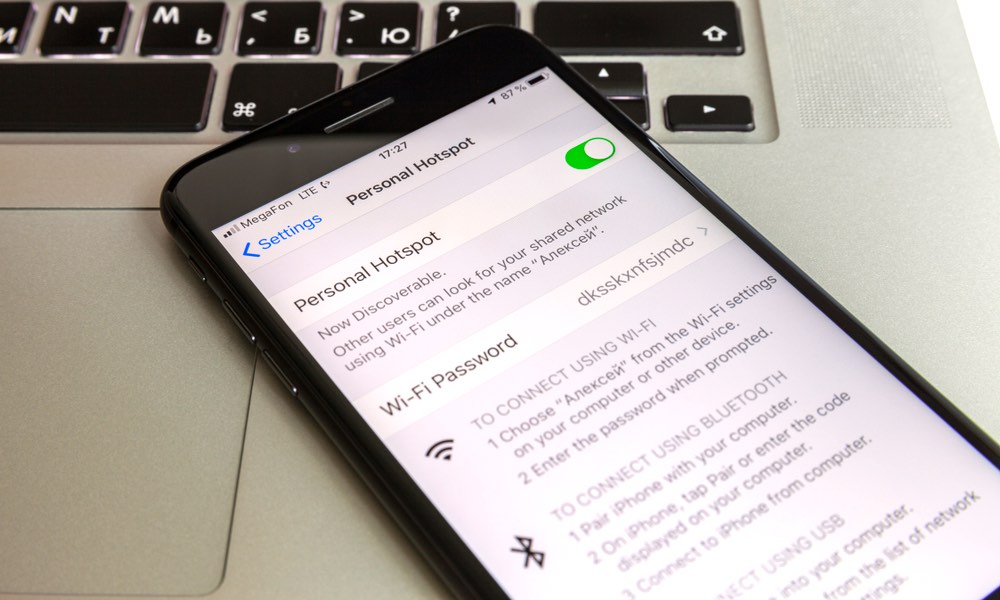Your iPhone 12’s Personal Hotspot Will Be Even Faster Thanks to This Hidden Upgrade
 Credit: Aleksey Khilko / Shutterstock
Credit: Aleksey Khilko / Shutterstock
Toggle Dark Mode
There’s already a lot of amazing stuff packed into Apple’s new iPhone 12 and iPhone 12 Pro, but along with super-fast 5G technology it seems that the new models have also quietly added a tweak that could give you an even faster connection when tethering your MacBook or iPad to your new iPhone.
Apple has offered a Personal Hotspot feature in the iPhone for over a decade — it first emerged with the iPhone 3GS in 2009, although it came to the older models as well as part of the “iPhone Software 3.0” update (what “iOS” was called back then). However, even as Apple’s iPhones began to add better and faster Wi-Fi capabilities, it seems that Personal Hotspot was always limited to only providing Wi-Fi service over the slower and considerably more congested 2.4GHz band.
To put this in perspective, Apple has offered the ability to use the much faster 5GHz Wi-Fi frequencies on outbound connections since it debuted the iPhone 5 back in 2012 — over eight years ago. Yet in all of that time, enabling Personal Hotspot still only ran over the 2.4GHz band, which also left users unable to take advantage of the much faster 802.11ac standard (now known as “Wi-Fi 5”), since that only operates in the 5GHz range.
To be fair, this wasn’t usually a big problem for most users, since the speeds offered by the older 802.11n Wi-Fi 4 were still capable of reaching 300Mbps — far more than any LTE cellular network could realistically deliver — but there were circumstances where it would have been nice to get off the very crowded and interference-prone 2.4GHz band, such as when working in busy airports, conference centers, and coffee shops.
While the 5GHz band has a more limited range, this is generally not an issue with Personal Hotspot, since it’s very unlikely your iPhone will be far enough away from your laptop or other device for that to be a problem, but again, for the most part, the extra performance just really wasn’t needed when sharing an LTE connection.
‘Maximize Compatibility’
Now, however, it looks like the entire iPhone 12 lineup has added support for using Personal Hotspot over the 5GHz band, as discovered by MacRumors’ Steve Moser.
The change was found in the form of a new “Maximize Compatibility” option in the Personal Hotspot settings, which is found exclusively on iPhone 12 models, and while Apple doesn’t bother to explain what the option does — it has yet to publish a support document on it, and makes no mention of it in its iPhone User Guide‚ Aaron Zollo confirmed from testing that it switches the feature from using the 5GHz band to using 2.4GHz instead.
In other words, it appears that the Personal Hotspot feature doesn’t actually use dual-band Wi-Fi — it still only advertises the hotspot on either 5GHz or 2.4GHz, so users who are tethering much older devices may need to flip this switch on to make sure that they can see their iPhone’s hotspot.
5G and 5GHz
The adoption of 5GHz Wi-Fi was almost certainly spurred by Apple’s move to 5G-capable iPhones, where cellular speeds can now easily reach or exceed 1Gbps — far more than 2.4GHz connections are capable of delivering.
To be clear, however, don’t let the fact that the first two characters are the same confuse you; 5G is short for fifth-generation cellular technology, and in fact runs on a wide range of frequencies, from T-Mobile’s nationwide 600MHz network to Verizon’s Ultra Wideband mmWave 39GHz.
In this context, on the other hand, 5GHz Wi-Fi refers to the frequencies that your Personal Hotspot Wi-Fi connection runs on, and has nothing directly to do with the cellular radios — except of course that it offers considerably faster bandwidth that will allow you to take full advantage of 5G speeds when tethering your laptop.
What This Means
If you’re fortunate enough to live or work within range of an mmWave 5G network, this will make a massive difference to your tethering speeds, since you’ll actually be able to link up your MacBook to your iPhone and get those 1Gbps+ speeds.
In fact, this offers performance that’s so much faster that you may find that it’s more efficient to tether your iPad to your iPhone — even if it has its own cellular connection — at least until Apple comes out with its first 5G iPad next year.
Of course, if your plan is subject to data caps, you’re going to want to be very careful, as you’ll burn through your allotment in no time at all when working at these kinds of speeds, so it’s really only advantageous to those on unlimited plans.
Keep in mind however that mmWave 5G is still very limited in deployment and range, so you’ll only find it in major urban centers, and in some cases it could come and go from block to block — that’s how short the ranges are that are available on the ultra-high 28GHz and 39GHz frequencies.
So if you’re on sub-6GHz 5G, you may find that the extra performance offered by the new 5GHz Personal Hotspot mode doesn’t really make that much of a practical difference in speed, but since it’s the new default and should still offer a connection that’s less prone to interference, there’s likely no need to worry about it, and you can safely leave it on unless you have a really old laptop, iPad, or other device that simply doesn’t offer 5GHz support, but these days those are pretty rare among the kind of consumer electronics that you’d want to use Personal Hotspot with.






